

| Noctua Yellow Underwing Moths - a guide to their identification |
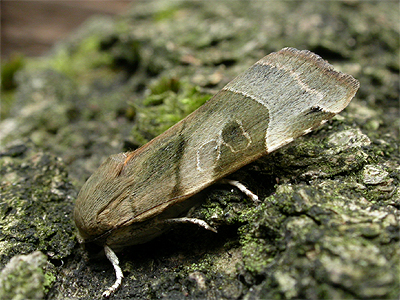 |
The Noctua Yellow
Underwings are a common group of large (macro) moths and
very regular to MV light. Some are occasionally noticed
during the day time by members of the public, with most
of these records probably being applicable to the
commonest of the group - the Large Yellow Underwing. This page provides brief descriptions of the five Noctua Yellow Underwings we currently have in Nottinghamshire and is intended as an ID guide for anyone coming across any of the following species. Our two larger species, the Large Yellow Underwing and Broad-bordered Yellow Underwing are both, large, robust moths. Large Yellow Underwings when coming to the moth trap in numbers, can actually be quite detrimental to other moths in the trap, with an almost suicidal disposition, often thudding into the light and causing disturbance, before eventually settling down. |
|
| ....... | ||
| Size comparisons If anyone is in any doubt as to which Yellow Underwing moth they have seen, then this set of size comparison images on the right may help. (not actual size) Variations Any degree of variation, seems to be totally within the two larger species. Both show huge variation in the ground colour of the forewings, but in the Large Yellow Underwing, variation is often considerable. |
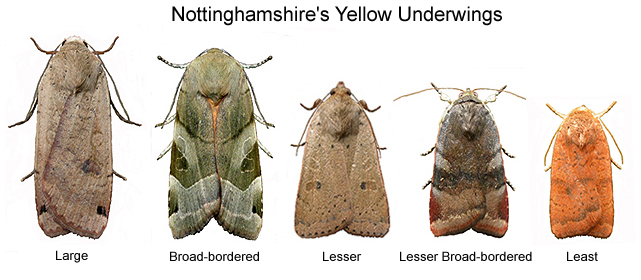 |
| ....... | ||
| Nottinghamshire
species Nottinghamshire has five species of Noctua Yellow Underwings. A sixth species, the Lunar Yellow Underwing, was lost from the county list since well before the publication of J.W. Carr's "The Invertebrate Fauna of Nottinghamshire" in 1916. Those species still found in Nottinghamshire are Large Yellow Underwing Noctua pronuba, Broad-bordered Yellow Underwing Noctua comes, Lesser Broad-bordered Yellow Underwing Noctua janthe and the Least Yellow Underwing Noctua interjecta. All four are presently classed as common. |
||
| 73.342 .... B&F 2107 .... Large Yellow Underwing Noctua pronuba (Linnaeus, 1758) |
Nottinghamshire status and distribution: Very common throughout Nottinghamshire. The most likely of the Yellow Underwings to be disturbed from leaf litter or low vegetation during the day and extremely common at MV light. Flight period: Flies from June to October, with a clear peak in numbers occurring in August. Identification features: A large and robust moth, which appears quite long and narrow when completely at rest. In very dry years, adults can occasionally be rather small. Large Yellow Underwing is an easily identified moth, despite there being considerable variation in forewing markings. Females are relatively plain and show a huge amount of variation in the ground colour of the forewings, ranging from pale sandy brown to a rich, dark plum colour. |
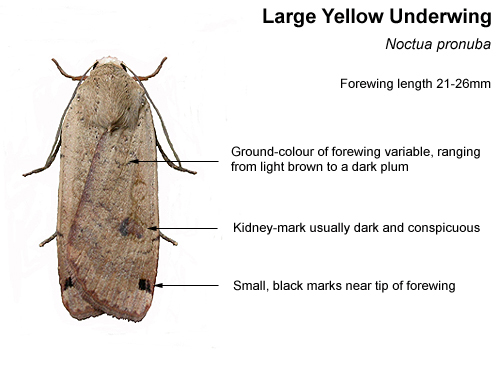 |
|
| ....... | ||
| Males are usually more well marked and intricately patterned. The small black marks near the tip of the forewing, are perhaps the most consistant feature among all individuals. Both oval and kidney-marks are present, the latter usually darker and conspicuous. | ||
| ....... | ||
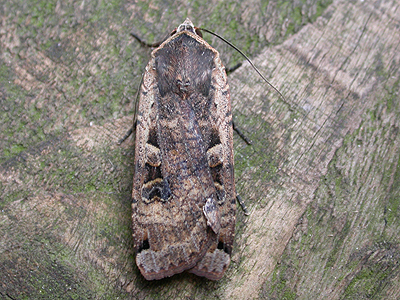 |
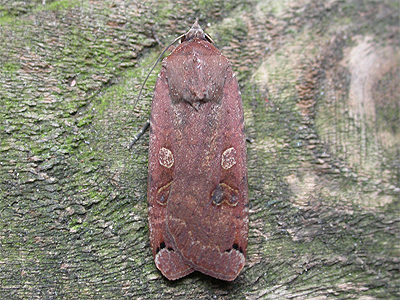 |
|
| 73.343 .... B&F 2110 .... Broad-bordered Yellow Underwing Noctua fimbriata
(Schreber, 1759) |
Nottinghamshire status and distribution: A common species in Nottinghamshire and frequently attracted to MV light, though in smaller numbers than the other Yellow Underwings. Rarely disturbed from low vegetation than the Large Yellow Underwing in our experience. Flight period: Has been recorded from June (one record) through to September. Apparently, after emergence, adults tend to go through a short diapause, before appearing again in August. However, the records we have available to us, show that peak numbers occur during July and that by August, the population has already declined by 50%. Identification features: Broad-bordered Yellow Underwing is an extremely distinctive species, which should really pose no identification problems. It is an attractive and beautifully marked moth, equal in size to Large Yellow Underwing, but more delicately marked. |
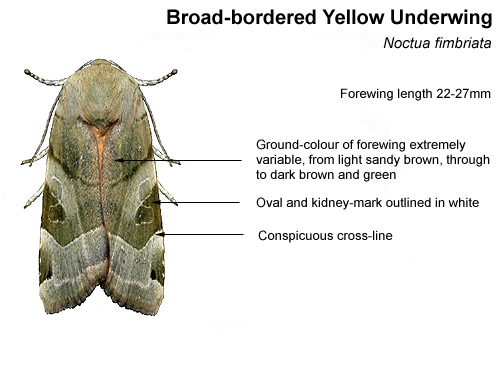 |
|
| ....... | ||
| The ground colour of the forewing is variable, ranging from a light yellow to dark brown, through to dark green. The oval and kidney-marks on the forewing, are usually little more that just white outlines, overlaid onto the forewing backround colour. | ||
| ....... | ||
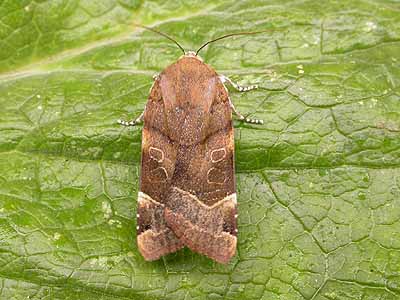 |
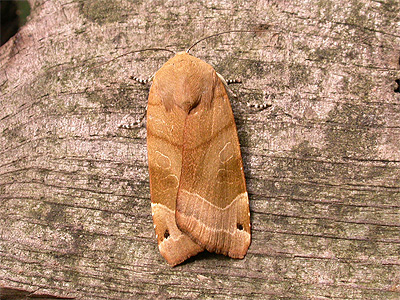 |
|
| 73.345 .... B&F 2109 .... Lesser Yellow Underwing Noctua comes (Hübner,
1813) |
| Nottinghamshire
status and distribution: Another common and very
widespread moth in Nottinghamshire and regular at MV
light. Found in most habitat types, including woodland and urban gardens and often disturbed from low vegetation or leaf litter during the day. Flight period: Flies from July to October, with a peak in in numbers occurring in both July and August. Identification features: Lesser Yellow Underwing is smaller than both Large and Broad-bordered Yellow Underwings. Forewing colouration is usually fairly consistant, being a light sandy brown and both oval and kidney-marks are usually quite conspicuous. When at rest, there is often a horizontal, well-spaced row of black dots near the base of the forewings and the edge of the forewing is characterised by a row of black marks, found on none of the other Underwings. |
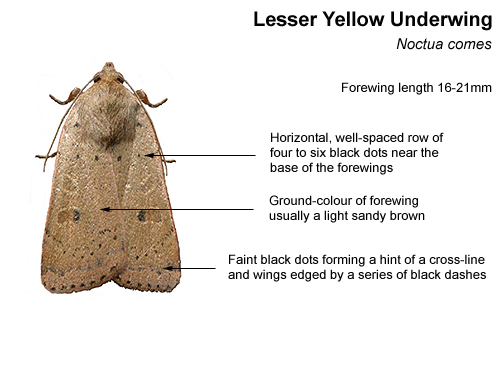 |
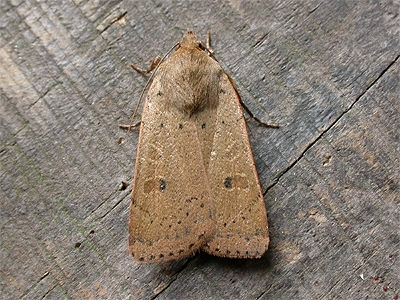 |
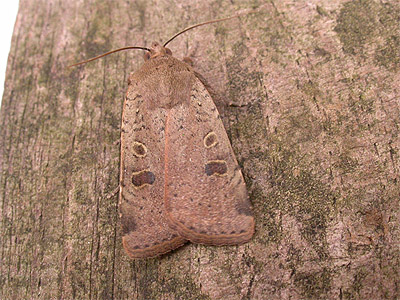 |
|
| 73.346 .... B&F 2112 .... Least Yellow Underwing Noctua interjecta (Schawerda, 1919) |
Nottinghamshire status and distribution: Probably more common throughout Nottinghamshire than our records would suggest and where it occurs, is fairly regular at MV light. Occasionally seen nectaring at flowers during the day, it can be found in more open rural areas and will occur in gardens. Flight period: July to August. Identification features: Adults are slightly smaller than the Lesser Broad-bordered Yellow Underwing, with the forewings being a bright fulvous-brown colour, though may be slightly darker when fresh. This moth should present few identiciation headaches, with no other UK moth even remotely resembling it. There are few conspicuous marks on the forewings, apart from blackish dots, forming poorly defined cross-lines. |
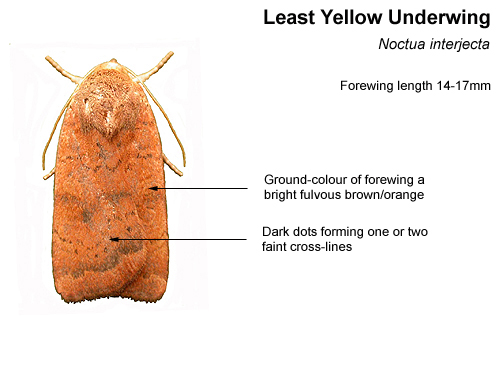 |
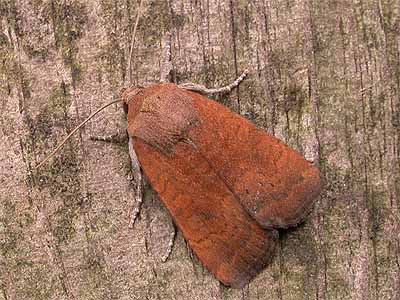 |
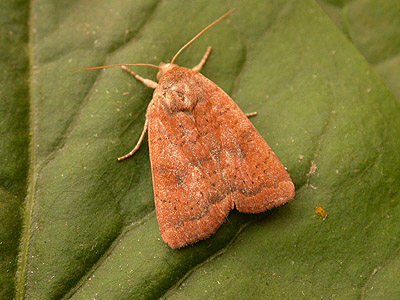 |
|
| 73.348 .... B&F 2111 .... Lesser Broad-bordered Yellow
Underwing Noctua janthe (Borkhausen, 1792) |
Nottinghamshire status and distribution: A common moth and very widespread moth in Nottinghamshire and like most of the Yellow Underwings, it is regularly attracted to MV light. Found in most habitat types, including woodland and urban gardens. Flight period: Flies from July to September, with a clear peak coming in August. Identification features: Smaller than both Large Yellow Underwing and Broad-bordered Yellow Underwing, the Lesser Broad-bordered Yellow Underwing is a beautifully marked moth. Fresh indviduals show a mix of subtle rusty-red, grey and olive markings on the forewings. The oval mark is outlined in white, but the kidney-mark is barely visible and only partially outlined. |
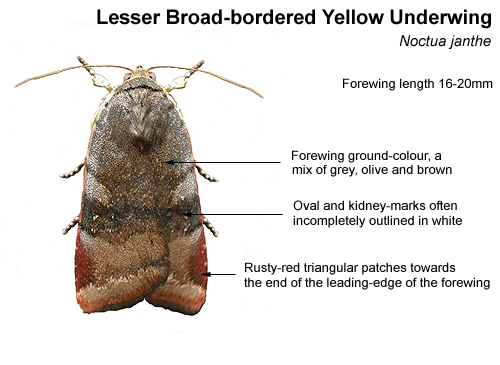 |
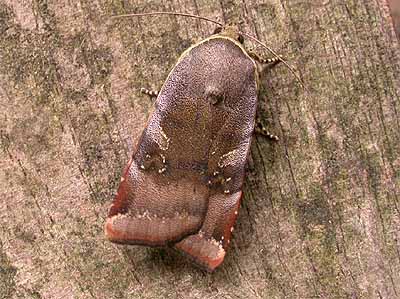 |
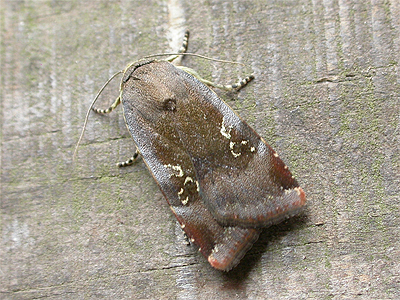 |
|